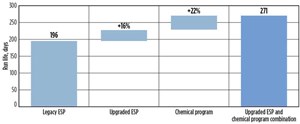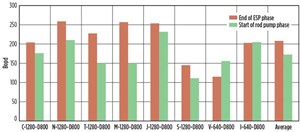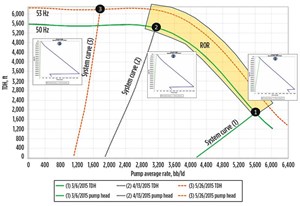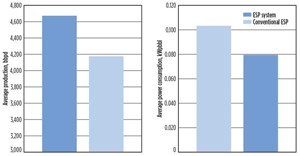Evolution of ESP technology enables economical application in unconventional wells
The electrical submersible pump (ESP) transformed U.S. oil production in the 20th century, but in the 21st century, the unconventional oil boom has demanded an upgraded ESP design. And to bring the changes full circle, new improvements in efficiency, performance and longevity benefit not only the North American unconventional oil and gas fields, but also challenging “conventional” reservoirs that would have seemed very unconventional, when the first ESPs were installed.
EVOLUTION OF ESP DESIGN
Armais Arutunoff developed the first ESPs for the company he founded (REDA) in 1916, to de-water ships and mines. His first major backer, however, was an oil and gas operator, and the slow evolution of ESP performance has largely followed the same track as the industry.

Pastre and Fastovets (2017) offer an excellent example of the typical systematic evolution in ESP performance in a North Sea field.1 From the 1980s through the 2010s, as the field matured, water cut, scale deposition and sand production increased. A first round of failure analysis determined that first-generation mechanical systems failed, due to erosion from unexpectedly high sand production. Iterative improvements to ESP designs improved the hardness of the stage material and the bearings; then shaft stability became the main cause of failure. And so on—with each failure mode stemming a new round of product improvement. Similar analysis and redesign were performed to improve the surface and downhole electrical systems.
After four generations, the “fit-for-basin” ESP system, combined with the rapidly evolving real-time surveillance service and smarter surface controllers, began delivering performance, efficiency and lifetime far beyond the original requirement. This has been done in an environment that was more demanding than the field’s early developers could have imagined they would need.
But the changes that made the ESP ideal for the challenging North Sea field—and other changes from similar continuous improvement projects with different challenges—soon became the backbones of a new technology optimized for today’s most challenging production environment. In fact, the robust pumps and gas-handling technology developed for conventional wells—together with motors and protectors that don’t require oil filling at wellsite—turned out to be critical for making ESPs work in unconventional wells.
Compounded challenges: Coping with new issues in the Eagle Ford shale. Initial attempts to produce unconventional wells with conventional ESPs determined that slow, steady ESP evolution was unlikely to produce useful technology quickly enough to meet market needs. ESP performance was hampered by too many factors at once. Ferguson (2013) describes the initial deployment of a conventional ESP in the Eagle Ford shale,2 “after three consecutive infant failures in only a few weeks … it was clear that the typical ESP operating approach is not a viable solution in the unconventional plays.”

The wells produced 40°-to-51° API oil and less than 25% water, with a GLR of 600 to 1,200 scf/bbl. The operator wanted to produce wells in three stages: natural flow, transitional artificial lift and beam pumps or gas lift. To accommodate the rapid production decline and manage output to the final stage, an unusually flexible ESP would be required: Initial expectations were production rates from 1,000 bopd at startup down to 200 bopd, plus a gas volume fraction (GVF) increase from negligible at startup to episodic slugs of 100% GVF.
In the first well, initial natural production of 1,749 bopd declined to 189 bopd after only four months, and water cut also changed from 48% to 21%. The operator installed the first REDA ESP system engineered from conventional technologies for the expected conditions. The initial ESP production increased to 965 bopd but declined over 20 days to 380 bopd, when facing the extremely challenging environment—and then three ESPs, in a row, failed in a short period.
The next ESP included the same pump and advanced gas-handling device type, but added multiphase gas-handling (MGH) devices, all built with compression-type construction to provide extended operating ranges to manage the steep decline in fluid flow. The new ESP also used variable-rating motors; a sinewave variable speed drive (VSD) to minimize potential harmonics and stress on the ESP electric system; and real-time surveillance and control systems to enable remote adjustments. In addition, new operating procedures were developed and implemented to manage gas locking and overheating.
The newly redesigned ESP was installed on Sept. 23, 2011, and was pulled out of the well one year later without any interim failures. The ESP system operated, at most times, in a cyclic operating regime. In its unconventional setting, the ESP accumulated a total of 1,478 starts—more than 10 times the starts a conventional ESP would accumulate in its full life cycle.
Incremental improvements: Delivering fit-for-basin technologies. The initial experience producing unconventional wells in the Eagle Ford proved that accelerated early production was possible using ESP systems, and that several factors were critical to that success. Namely, the toughness and reliability of existing power and control components, the criticality of open collaboration between the operator and ESP supplier, and the opportunities to improve the reliability of wet components to mitigate the effects of pumping abrasive and slugging multiphase flow.
To enable additional changes for unconventional well requirements, a bespoke and unique engineering process also was developed, leveraging digital design tools combined with supercomputing power and optimization engines to fine-tune pump and stage geometry. This vastly improved lift performance while minimizing the negative impact from free gas and solids. Innovative design and manufacturing, and rapid prototyping tools enabled shortening of the development cycle, as best digital designs could be manufactured and tested immediately at the Schlumberger Qualification and Testing Facility in Singapore. As a result, the second generation quickly followed, and the ESP configuration included the D1050N, the first mixed flow pump stage for low rates, with a recommended operating range of 300 to 1,650 bpd at 60 Hz.
Control algorithms were automated and built into the firmware for gas lock protection in the motor controller. Combined with the availability of 24/7 surveillance and remote control, and the reliability improvements in wet components (pumps, gas handlers, gas separator), the algorithms enabled significant improvement in uptime and run life of ESP systems.
Although the success rate of riding through low- or no-flow events improved substantially, resulting in increased production, up-time and run life, mechanical failures continued to occur, due to excessive stress on the system. Each failure contributes to continuous improvement efforts, aimed at identifying the next potential weak point and developing solutions, such as manufacturing and an improved protector configuration.
The lessons learned, and corrective actions proven, in the first unconventional ESP installations in the Eagle Ford, were implemented across North America’s unconventional basins. There, they faced more challenges, and these challenges differed from basin to basin, and even from field to field within a basin.
For example, in one field in the Williston basin, erosion from proppant flowback caused most ESP failures, but in another Williston basin field, the biggest challenge was corrosion.

In 2016, Schlumberger provided a customized extended-life ESP and well treatment program for a major Williston basin operator. A Schlumberger production technologies team conducted an extensive field survey, collecting well fluid samples for laboratory analysis to better understand the wellbore chemistry. The artificial lift team used this information to improve and update the design of the pump with metallurgy and elastomers, tailored to combat the corrosive environment. The integrated effort resulted in a 38% improvement in run life. Pump design changes increased ESP run life 16%, and the custom chemical treatment plan, which included a newly developed scale and corrosion inhibitor, extended it by a further 22%, to an average 271 days, Fig. 1.
This integrated approach represented a significant step change for artificial lift operations. Today, however, unconventional operators expect even more from ESP solutions to better manage production declines. This is especially true, as operators seek to extend the duration of the ESP lifting cycle to minimize the production disruption and cost of transitioning to beam pumps. Where operators were once content with a run life of several months, the expectation has increased steadily to six months, a year, then two years and beyond.
Today’s pumps: Exploring the left side of the pump curve. Darling (2015) presented a case study of eight unconventional wells in the Powder River basin, where ESP systems were used to effectively manage the drawdown by reducing the pump intake pressure (PIP) from 4,000 psi to 100-200 psi before transitioning to rod pumps, when fluid production declined to 150 to 250 bpd.3 Because of the relatively low rate, the ESP systems used radial stages and redundant gas handling equipment. The gas handling technology, combined with operational procedures, was instrumental in maintaining pump uptime, even with radial pump stages maintaining pump intake pressure of less than 200 psi. Unfortunately, upon transitioning from ESPs to rod pumps, oil production was, on average, 17% lower than the average production at the end of the transitional ESP phase, Fig. 2.

Both mixed- and radial-flow centrifugal pumps can be used for conventional production, but mixed-flow pumps are much better-suited for multiphase flow—like the high-GVF flow in North American unconventional plays. However, the early mixed-flow pumps did not achieve the required reliability in the most challenging applications dealing with high solids, unsteady multiphase flow, long ESP strings with MGH devices and steep production decline, which results in excessive axial stress. The service provider recognized that to meet the full range of customers’ needs, further pump development was required. The hydraulic performance of the pump and gas handler stages is now configured, modelled and optimized using turbomachinery design tools. It is then validated through extensive tests of assembled pumps including sand loop testing.
In another example, Narvaez (2016) illustrated the Bakken shale case of a new well that needed the extreme range of the newly designed RC4000 REDA Continuum extended-life ESP pump after a short period of natural flow. The ESP system managed the decline from initial production of 4,950 bopd with a PIP of 4,200 psi to 1,595 bopd and 890 psi. Figure 3 captures the evolution of the operating point in the pump head flowrate performance curve during this ESP phase, successfully managing the well decline, even when the rate dropped below the pump catalog’s recommended operating range (ROR).
Keeping the recognizable geometry, but with significant improvements in mechanical design, has made the elusive “wide-and-low-flow-range ESP” achievable. The addition of a new radial bearing system, adding axial stiffness to the impellers’ stack, and hydraulic balancing of the stages to minimize the axial load (downthrust), means that even at the bottom of the curve, the pump remains reliable.
Global impacts: Implementing improvements back to conventional wells. To bring the continuous improvement cycle full circle, the robust technologies developed for unconventional challenges are now being used to solve problems in increasingly challenging conventional wells.
In 2017, Schlumberger delivered a solution in Western Siberia, where ESPs in a mature field were plagued with increasing sand production and scale formation, which resulted in power increases and frequent pump failures. The operator, Salym Petroleum, changed out conventional equipment for engineered ESPs with RC4000 pumps, and added surveillance with the Lift IQ production life cycle management service. After the new ESP system was installed, the average power consumption per bbl of liquid produced dropped 20% from 0.1 to 0.08 kW/bbl, mainly attributed to increased pump efficiency, but also because of Lift IQ service adjustments to maximize that efficiency, Fig. 4. In addition, the average well production increased 12%, from 4,180 to 4,680 bopd, because the pump design and Lift IQ service optimization enabled higher drawdown.
BEST PRACTICES
With 100 years of experience designing and deploying ESPs in challenging wells, a few essential lessons learned stand out.
Monitoring is critical. In a conventional application, downhole monitoring is a “nice to have,” but for unconventional, it’s a “must have.” Data acquisition, alone, does not improve performance. Kutluev (2018) described a case in which an operator selected 22 critical unconventional wells for 24/7 surveillance and 17 for data reporting only.5 After a year, the ESPs with full surveillance had uptime between 91.5% and 95.7%; the wells with data reporting only had uptime of 57% to 67.9%.
The right ESP must go into the right well. The ESP system should have enough flexibility and reliability to deliver operator goals of production, uptime, and run life. The application engineering process must include sensitivity analysis that models the evolving conditions, including fluid properties, pressure and production. The correct ESP system then can be selected to manage the high initial production, and the production decline for as long as possible, then transition to a second or third lower-rate ESP to extend the transitional artificial lift phase. The newest REDA Continuum LF low-flow, extended-life ESP pump is designed to extend production before transitioning to rod pumps or another low-flow artificial lift system for the tail of the life of the well.
Collaboration and continuous improvement are crucial. An ESP system engineered with flexibility and reliability to adjust to dynamic operating conditions, installed with the proper downhole and surface sensors, VSD and motor controller compatible with advanced 24/7 surveillance and remote control, is the foundation. But the biggest lesson learned from 100 years of continuous improvement is that there’s always one more problem to solve. And then one more after that. As a result, close collaboration between the operator and ESP supplier is crucial to pushing the envelope for production, up-time and run life.
REFERENCES
- Pastre, L. F., A. Fastovets, “The evolution of ESP technology in the North Sea: A reliability study based on historical data and survival analysis,” SPE paper 187735-MS, presented at the SPE Russian Petroleum Technology Conference in Moscow, Russia, Oct. 16-18, 2017.
- Ferguson, H. C., K. J. Robbins, D. Narvaez, “Artificial lift ESP solutions for the unconventional plays in Eagle Ford shale,” presented at the SPE Gulf Coast Section ESP Workshop in the Woodlands, Texas, April 24-26, 2013.
- Darling, D. H., D. Kutluev, W. H. Zhuang, D. A. Narvaez, “Managing unsteady multi-phase flow from horizontal wells with ESP systems,” presented at the 2015 SPE Gulf Coast Section ESP Workshop in the Woodlands, Texas, April 22-24, 2015.
- Narvaez, D., D. Eslinger, M. Perez, T. Dvorak, “Enhanced pump technology adapts to extreme operating conditions in multiphase producing wells,” SPE paper 181234-MS, presented at the SPE North American Artificial Lift Conference and Exhibition in the Woodlands, Texas, Oct. 25-27, 2016.
- Kutluev, D., M.E.Q. Bravo, A. Jasim, “A 24/7 surveillance service improved ESP uptime in U.S. unconventional reservoirs: A case study,” SPE paper 192512-MS, presented at the SPE Middle East Artificial Lift Conference and Exhibition in Manama, Bahrain, Nov. 28-29, 2018.
- Advancing offshore decarbonization through electrification of FPSOs (March 2024)
- U.S. oil and natural gas production hits record highs (February 2024)
- What's new in production (October 2023)
- FPSO technology: Accelerating FPSO performance evolution (September 2023)
- What's new in production (August 2023)
- A step-change in chemical injection (August 2023)
- Applying ultra-deep LWD resistivity technology successfully in a SAGD operation (May 2019)
- Adoption of wireless intelligent completions advances (May 2019)
- Majors double down as takeaway crunch eases (April 2019)
- What’s new in well logging and formation evaluation (April 2019)
- Qualification of a 20,000-psi subsea BOP: A collaborative approach (February 2019)
- ConocoPhillips’ Greg Leveille sees rapid trajectory of technical advancement continuing (February 2019)


